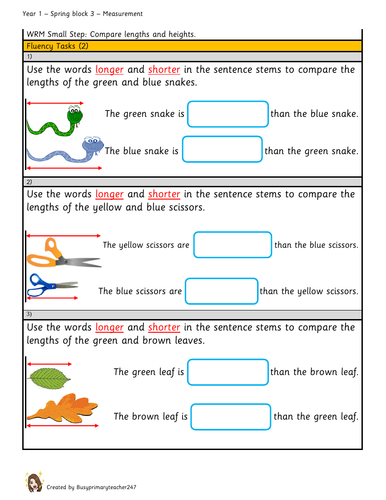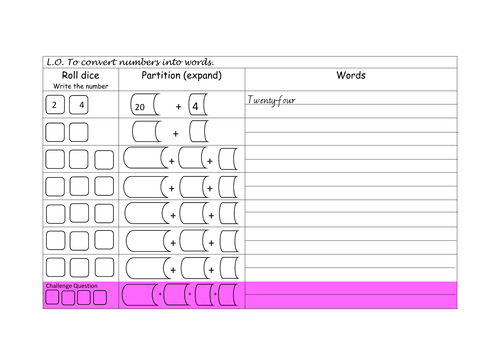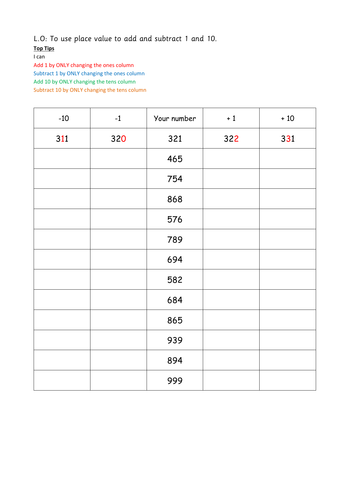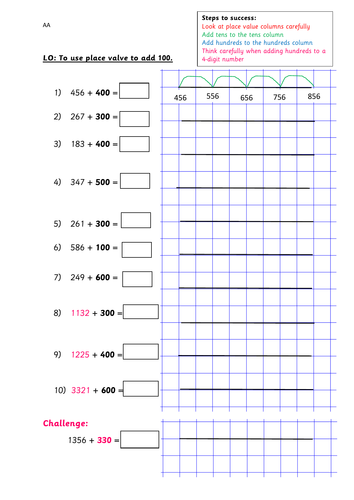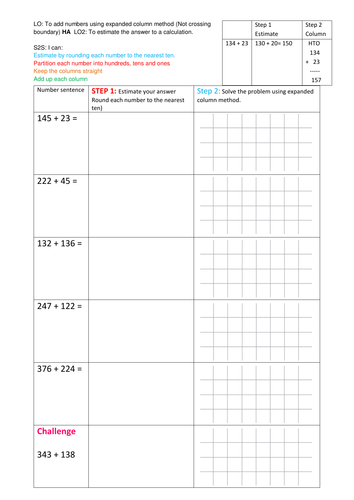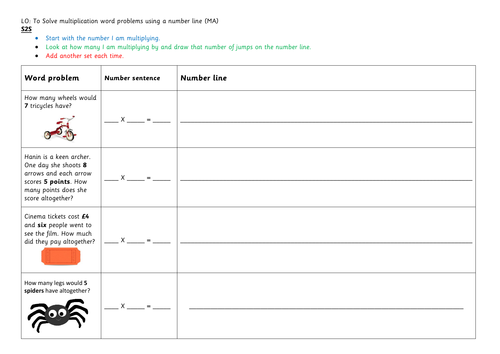132Uploads
175k+Views
66k+Downloads
All resources

Year 3 - Identifying horizontal, vertical, parallel and perpendicular lines
Worksheet / assessment focusing on identifying horizontal, vertical, parallel and perpendicular lines. Differentiated BA and A AA (Includes Greater depth question)
Links with Year 3 National Curriculum and Rising Stars objectives.

Year 3 Question Strips - Addition and Subtraction
This resource includes pictorial and abstract representations to go with fluency, reasoning and problem solving tasks. It compliments weeks 4 - 8 of WRM addition and subtraction unit and contains 25 five-a-day activities to help develop mastery.
Year 3 National Curriculum Objectives covered:
- Add and subtract numbers mentally, including: a three-digit number and ones; a three-digit number and tens; a three digit number and hundreds.
- Add and subtract numbers with up to three digits, using formal written methods of columnar addition and subtraction.
- Estimate the answer to a calculation and use inverse operations to check answers.
- Solve problems, including missing number problems, using number facts, place value, and more complex addition and subtraction.

Year 4 - Fractions - Spring block 3 ( week 7)
This resource includes varied fluency questions that focus on ‘Subtracting two fractions’ and ‘Subtract from whole amounts’. It follows a concrete – pictorial – abstract approach for mastery and also includes reasoning and problem-solving questions. Differentiated two ways and includes answers.
WRM Small Steps
Subtracting two fractions
Subtract from whole amounts
Curriculum links
• Solve problems involving increasingly harder fractions to calculate quantities, and fractions to divide quantities, including non-unit fractions where the answer is a whole number.
• Add and subtract fractions with the same denominator.
I hope you find this resource useful!
Your feedback is always welcome x

Year 1 - Measurement - Comparing lengths (varied fluency 2)
This resource supports Year 1 Measurment - Comparing length and heights. Children compare lengths of a variety of objects using the vocabulary ‘longer’ and ‘shorter’. (Varied fluency 2). Answers are included in the PDF.
Curriculum links
Compare, describe and solve practical problems for: lengths and heights (for example, long/short, longer/shorter, tall/short.
Enjoy x
All images used in this resource are from
Bundle

Year 4 Fractions Bundle
This bundle includes everything you need to teach fractions. Each resource follows a concrete – pictorial – abstract approach for mastery and includes opportunities to use number lines, bar models and concrete materials. It also includes varied fluency, reasoning and problem-solving questions. Differentiated two ways and includes answers.
Topics included:
• What is a fraction?
• Equivalent fractions (1)
• Equivalent fractions (2)
• Fractions greater than 1
• Count in fractions
• Add 2 or more fractions
• Subtract 2 fractions
• Subtract from whole amounts
• Calculate fractions of a quantity
• Problem solving – calculate quantities
National Curriculum Links
• Recognise and show, using diagrams, families of common equivalent fractions.
• Count up and down in hundredths; recognise that hundredths arise when dividing an object by one hundred and dividing tenths by ten.
• Solve problems involving increasingly harder fractions to calculate quantities, and fractions to divide quantities, including non-unit fractions where the answer is a whole number.
• Add and subtract fractions with the same denominator.
Your feedback is always welcome x

Year 3 5-a-day maths activities Number and Place Value
The resources in this download covers Year 3 Place Value for weeks 1 to 3 of the autumn term. They support a mastery approach to teaching mathematics. Concrete-Pictorial-Abstract is promoted throughout.
All 15 tasks are designed as a 5-minute warm up activity at the beginning of Maths lessons.
Year 3 curriculum objectives covered are:
- Identify, represent and estimate numbers using different representations.
- Find 10 or 100 more or less than a given number.
- Recognise the place value of each digit in a three-digit number (hundreds, tens, ones).
- Compare and order numbers up to 1000.
- Read and write numbers up to 1000 in numerals and in words.
- Solve number problems and practical problems involving these ideas.
- Count from 0 in multiples of 50 and 100.
Enjoy! your feedback is always welcome x

Year 3 - Writing 3-digit numbers in words
Worksheet and dice activity based on writing 2- and 3-digit numbers in words. Also includes partitioning.

10 more 10 less, 1 more 1 less (3-digit numbers)
Year 3 worksheet focused on 10 more 10 less, 1 more 1 less (3-digit numbers) 2 differentiated sheets.

Year 3 adding multiples of 100 to 3-digit numbers using a numberline
Worksheet based on adding multiples of 100 to 3-digit numbers using jumps on a number line. Includes a challenge 4-digit number question.

Year 3 Maths Warm Up - QR Code Scavenger Hunt 2
A fun way to start any maths lesson and a great way to include technology. This activity is designed to be used with I Pads (Or a similar device with a QR code reader).
Steps:
- Print off and cut out each code.
- Place QR codes around the classroom.
- Children work individually (or in groups depending on available devices) and move around the room solving each problem in order.
- There is also a secret code at the end , so that you know they have completed the hunt.
Answer sheet included.
Enjoy! Your feedback is always welcome x

Year 3 Maths Warm Up - QR Code Scavenger Hunt 1
A fun way to start any maths lesson and a great way to include technology. This activity is designed to be used with I Pads (Or a similar device with a QR code reader).
Steps:
- Print off and cut out each code.
- Place QR codes around the classroom.
- Children work individually (or in groups depending on available devices) and move around the room solving each problem in order.
- There is also a secret code at the end , so that you know they have completed the hunt.
Answer sheet included.
Enjoy! Your feedback is always welcome x

Year 3 Maths Warm Up - QR Code Scavenger Hunt 3
A fun way to start any maths lesson and a great way to include technology. This activity is designed to be used with I Pads (Or a similar device with a QR code reader).
Steps:
- Print off and cut out each code.
- Place QR codes around the classroom.
- Children work individually (or in groups depending on available devices) and move around the room solving each problem in order.
- There is also a secret code at the end , so that you know they have completed the hunt.
Answer sheet included.
Enjoy! Your feedback is always welcome x

Year 3 - 3-digit by 2-digit column addition with estimating and rounding (No exchanging)
Year 3
3-digit by 2-digit column addition with estimating and rounding (No exchanging) Differentiated worksheets BA, MA, HA
Enjoy! Your feedback is always welcome x

Year 3 - Using a number line to solve multiplication word problems - Differentiated
Year 3 - Using a number line to solve multiplication word problems - Differentiated BA, MA, HA
Enjoy! Your feedback is always welcome x

Year 3 - question strips linked to - Multiplication and Division (CPA) block 3 - Autumn week 10
This resource contains 5, question strips that follow the maths mastery approach (CPA - Concrete, pictorial, abstract). They match week 10 of Multiplication and Division for Autumn term.
Links to year 3 National Curriculum
- Recall and use multiplication and division facts for the 3, 4 and 8 multiplication tables.
- Write and calculate mathematical statements for multiplication and division using the multiplication tables they know, including for two-digit numbers times one-digit numbers, using mental and progressing to formal written methods.
- Solve problems, including missing number problems, involving multiplication and division, including positive integer scaling problems and correspondence problems in which 'n' objects are connected to 'm' objectives.
Enjoy!
Your feedback is always welcome x

Year 3 Question strips linked to block 3 - Multiplication and Division (Autumn Week 9)
A set of 5 questions strips based on a maths mastery approach (concrete - pictorial - abstract) for Multiplication and Division (Autumn term, week 9).
Links to:
Year 3 National curriculum objectives:
- Recall and use multiplication and division facts for the 3, 4 and 8 multiplication tables.
- Write and calculate mathematical statements for multiplication and division using the multiplication tables they know, including for two-digit numbers times one-digit numbers, using mental and progressing to formal written methods.
- Solve problems, including missing number problems, involving multiplication and division, including positive integer scaling problems and correspondence problems in which 'n' objects are connected to 'm' objectives.
Enjoy!
Your feedback is always welcome x

5 question strips linked to Year 3 Multiplication and division, Autumn week 11
This resource contains 5 question strips that link to Multiplication and Division Autumn week 11. They follow the mastery approach (concrete, pictorial, abstract) to help pupils develop a deep understanding. Problem-solving and reasoning questions are also included.
National Curriculum links:
- Recall and use multiplication and division facts for the 3, 4 and 8 multiplication tables.
- Write and calculate mathematical statements for multiplication and division using the multiplication tables they know, including for two-digit numbers times one-digit numbers, using mental and progressing to formal written methods.
- Solve problems, including missing number problems, involving multiplication and division, including positive integer scaling problems and correspondence problems in which 'n' objects are connected to 'm' objectives.
Enjoy! Your feedback is always welcome x

Year 3 - Question strips based on block 1, Multiplication and Division, Spring Term , week 1
This resource has been created to match block 1, week 1 of the spring term - Multiplication (for year 3). They follow the concrete-pictorial-abstract method of Maths Mastery and also include problem-solving and reasoning questions.
Links to WRM small steps:
-Comparing statements
-Related calculations
-Multiply 2-digits by 1-digit (1)
Links to the National Curriculum:
- Recall and use multiplication and division facts for the 3, 4 and 8 multiplication tables.
- Write and calculate mathematical statements for multiplication and division using the multiplication tables they know, including for two-digit numbers times one-digit numbers, using mental and progressing to formal written methods.
- Solve problems, including missing number problems, involving multiplication and division, including positive integer scaling problems and correspondence problems in which n objects are connected to m objectives.
Enjoy! Your feedback is always welcome.
Pictures used in this resource have been created by Busyprimaryteacher247
Other images sourced from - https://wpclipart.com

Year 2 - Spring Term - week 1 - Multiplication and Division
This resource covers the first 3 small steps for year 2, Spring, week 1 Multiplication, and Division.
This pack contains a series of differentiated worksheets (and answers) that follow the concrete, pictorial and abstract method for maths mastery. They also include reasoning and problem-solving.
Curriculum links:
- Recall and use multiplication and division facts for the 2, 5 and 10 times tables, including recognising odd and even numbers.
- Calculate mathematical statements for multiplication and division within the multiplication tables and write them using the multiplication (×), division (÷) and equals (=) signs.
- Solve problems involving multiplication and division, using materials, arrays, repeated addition, mental methods and multiplication and division facts, including problems in contexts.
- Show that the multiplication of two numbers can be done in any order (commutative) and division of one number by another cannot.
I hope these are helpful!!
Your feedback is always welcome x
Most images created by Busyprimaryteacher247
All other images sourced from: https://wpclipart.com/index.html

Year 3 - Spring week 1 - Multiplication and Division
This set of resources follows the concrete-pictorial-abstract method of Maths Mastery. It contains fluency, reasoning and problem-solving tasks.
The worksheets are differentiated between lower ability and age-related and the answers are included :)
Links directly to WRM small steps:
- Comparing statements
- Related calculations
- Multiply 2-digits by 1-digit (1)
National curriculum links:
-Recall and use multiplication and division facts for the 3, 4 and 8 multiplication tables.
-Write and calculate mathematical statements for multiplication and division using the multiplication tables they know, including for two-digit numbers times one-digit numbers, using mental and progressing to formal written methods.
-Solve problems, including missing number problems, involving multiplication and division, including positive integer scaling problems and correspondence problems in which n objects are connected to m objectives.
I hope you find these resources helpful!
Your feedback is always welcome x




